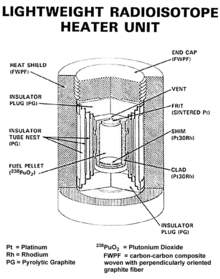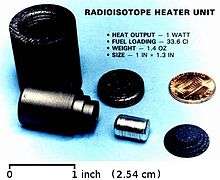Radioisotope heater unit
Radioisotope heater units (RHU) are small devices that provide heat through radioactive decay. They are similar to tiny radioisotope thermoelectric generators (RTG) and normally provide about one watt of heat each, derived from the decay of a few grams of plutonium-238—although other radioactive isotopes could be used. The heat produced by these RHUs is given off continuously for several decades and, theoretically, for up to a century or more.[1]

In spacecraft, RHUs are necessary to heat critical components and subsystems. RHUs also reduce spacecraft complexity by making heater subsystems unnecessary. By having as few heating subsystems as possible, the overall complexity of the spacecraft can be reduced.[1]
While both RHUs and RTGs use the decay heat of a radioactive isotope (usually Pu-238), RHUs are generally much smaller as a result of omitting the thermocouples and heat sinks/radiators required to generate electricity from heat. Both RHUs and RTGs feature rugged, heat-resistant casings to safely contain the radioisotope in the event of a launch or re-entry vehicle failure. The total mass of a single RHU (including shielding) is about 40 grams. Similar schemes, such as thermo-ionic generators, have also been used.
Spacecraft use

Most lunar and Martian surface probes use RHUs for heat, including many probes that use solar panels rather than RTGs to generate electricity. Examples include the seismometer deployed on the Moon by Apollo 11 in 1969, which contained 1.2 ounces (34 grams) of plutonium-238; Mars Pathfinder; and the Mars Exploration Rovers Spirit and Opportunity. RHUs are especially useful on the Moon because of its lengthy and cold two-week night.
Virtually every deep space mission beyond Mars uses both RHUs and RTGs. Solar insolation decreases with the square of the distance from the Sun, so additional heat is needed to keep spacecraft components at nominal operating temperature. Some of this heat is produced electrically because it is easier to control, but electrical heaters are far less efficient than a RHU because RTGs convert only a few percent of their heat to electricity and reject the rest to space.
The Cassini–Huygens spacecraft sent to Saturn contained eighty-two of these units (in addition to three main RTGs for power generation). The associated Huygens probe contained thirty-five.
The United States Department of Energy has developed the General Purpose Heat Source (GPHS) primarily for space use. These GPHSes can be used individually or in groups of up to eighteen for component heating and sources for RTGs. Each GPHS contains four iridium-clad Pu-238 fuel pellets, standing 5 cm tall, 10 cm square and weighs 1.44 kg.
References
- "Department of Energy Facts: Radioisotope Heater Units" (PDF). U.S. Department of Energy, Office of Space and Defense Power Systems. December 1998. Retrieved March 24, 2010.
External links
- NASA Radioisotope Power Systems website – RHU page
- Radioisotope heater unit fact sheet from NASA's Cassini mission website